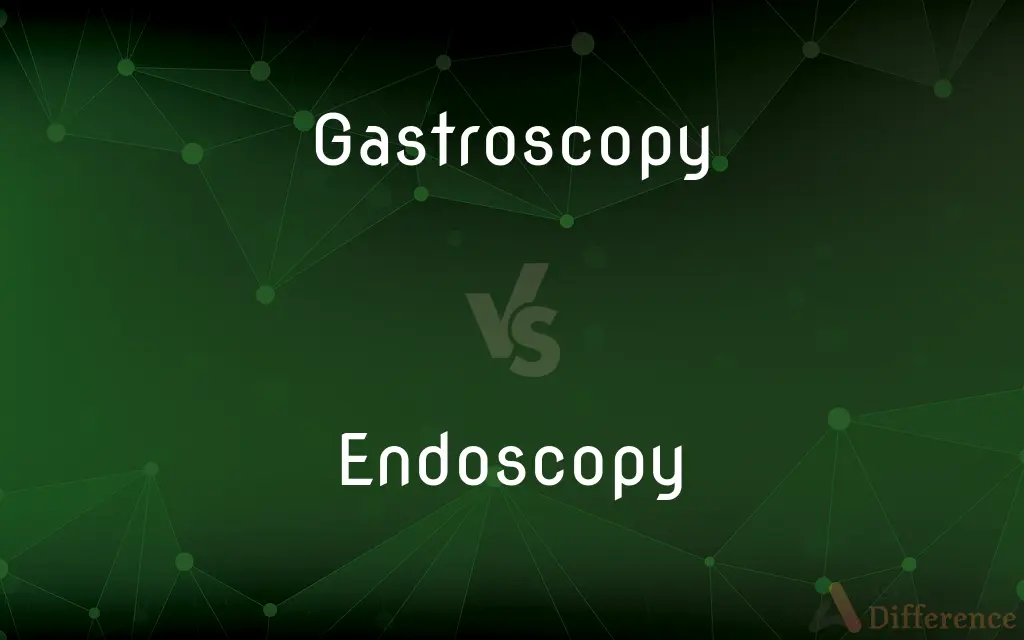Gastroscopy vs. Endoscopy — What's the Difference?
Edited by Tayyaba Rehman — By Fiza Rafique — Updated on October 30, 2023
Gastroscopy is a type of endoscopy specifically for examining the upper part of the gastrointestinal tract. Endoscopy is a broader term for procedures using an endoscope to examine the interior of a body cavity or organ.

Difference Between Gastroscopy and Endoscopy
Table of Contents
ADVERTISEMENT
Key Differences
Gastroscopy and Endoscopy are both medical procedures that involve the use of a flexible tube with a light and camera attached to it. The distinction lies in their specific applications and areas they examine.
Gastroscopy is exclusively centered around examining the upper part of the gastrointestinal tract, such as the esophagus, stomach, and the upper part of the small intestine. It provides detailed images to diagnose issues like ulcers, inflammation, or tumors.
On the other hand, Endoscopy is a more generic term. It covers various procedures aimed at visualizing the interior of body cavities and organs. This includes not only gastroscopy but also bronchoscopy (lungs), colonoscopy (colon), and more.
Both Gastroscopy and Endoscopy are invaluable diagnostic tools for physicians. While a gastroscopy zeroes in on a specific area, an endoscopy can pertain to any procedure where an endoscope is used to observe internal structures without invasive surgery.
In sum, while all gastroscopies are endoscopies, not all endoscopies are gastroscopies. The distinction is based on the specific region of the body being examined.
ADVERTISEMENT
Comparison Chart
Definition
Examines upper GI tract
Examines internal body cavities/organs
Scope
Specific to stomach, esophagus
Broader including lungs, colon, etc.
Instrument Used
Type of endoscope
Endoscope
Diagnostic Uses
Ulcers, tumors in upper GI
Various, based on body part
Invasiveness
Minimally invasive
Minimally invasive
Compare with Definitions
Gastroscopy
A procedure to view the esophagus, stomach, and duodenum.
She underwent a gastroscopy to determine the cause of her stomach pain.
Endoscopy
A procedure to view inside body cavities using an endoscope.
The doctor performed an endoscopy to check for any obstructions.
Gastroscopy
An examination of the upper digestive tract using a gastroscope.
The doctor recommended a gastroscopy after he complained of persistent heartburn.
Endoscopy
A method to visualize internal structures without major surgery.
Thanks to endoscopy, they detected the issue without any invasive procedure.
Gastroscopy
A diagnostic method for observing the lining of the upper GI.
Suspected ulcers often warrant a gastroscopy for confirmation.
Endoscopy
A diagnostic tool that inserts a camera into body passages.
She was feeling nervous about her upcoming endoscopy.
Gastroscopy
A visualization technique for the upper gastrointestinal region.
The gastroscopy revealed an inflammation in the lining of his stomach.
Endoscopy
Examination of interior body parts using a flexible instrument.
He had an endoscopy to investigate his chronic cough.
Gastroscopy
An endoscopic procedure focused on the stomach and upper intestine.
Due to her difficulty swallowing, she was scheduled for a gastroscopy.
Endoscopy
A medical imaging technique for internal examination.
The endoscopy results showed no signs of inflammation.
Gastroscopy
An endoscope that is inserted through the mouth and used for examining the interior of the stomach.
Endoscopy
An endoscopy (looking inside) is a procedure used in medicine to look inside the body. The endoscopy procedure uses an endoscope to examine the interior of a hollow organ or cavity of the body.
Gastroscopy
An examination of esophagus, stomach and duodenum using endoscope.
Endoscopy
A slender, tubular instrument, such as an arthroscope or laparoscope, that is inserted into a body cavity or part for the purpose of visual examination, diagnosis, or surgical treatment.
Gastroscopy
Examination of the abdomen or stomach, as with the gastroscope.
Endoscopy
(medicine) The examination of a bodily orifice, canal or organ using an endoscope.
Gastroscopy
Visual examination of the stomach by means of a gastroscope inserted through the esophagus
Endoscopy
The art or process of examination or treatment by means of an endoscope.
Endoscopy
Visual examination of the interior of a hollow body organ by use of an endoscope
Common Curiosities
Can Gastroscopy detect cancer?
Yes, it can detect abnormalities, including tumors, in the upper GI tract.
What is a Gastroscopy used for?
Gastroscopy is used to examine the upper part of the gastrointestinal tract.
How long does a Gastroscopy procedure take?
Typically, a gastroscopy lasts about 15-20 minutes.
How often should one get an Endoscopy?
Frequency depends on the medical condition and doctor’s recommendation.
Is an Endoscopy painful?
Patients are usually sedated, making the procedure comfortable.
Is Gastroscopy the same as a stomach scope?
Yes, it's another term for examining the stomach using a scope.
Is Endoscopy an outpatient procedure?
Yes, patients typically go home the same day.
Can Endoscopy detect IBS?
While it can detect inflammation, IBS is often diagnosed using multiple methods.
Is an Endoscopy only for the digestive tract?
No, endoscopy covers various procedures, including examining lungs, colon, and more.
Why would a doctor recommend a Gastroscopy?
To diagnose issues like ulcers, inflammation, or tumors in the upper GI.
How soon can one eat after a Gastroscopy?
Once the sedation wears off, usually within a few hours.
How should one prepare for a Gastroscopy?
Usually by fasting for several hours before the procedure.
Are there risks associated with Endoscopy?
All procedures have risks, but complications with endoscopy are rare.
Are there alternatives to Endoscopy?
Imaging tests like X-rays or CT scans can be alternatives, depending on the issue.
What's the main difference between Gastroscopy and Endoscopy?
Gastroscopy is specific to the upper GI, while Endoscopy can pertain to various body parts.
Share Your Discovery

Previous Comparison
Aboard vs. Onboard
Next Comparison
Immerse vs. ReimmerseAuthor Spotlight
Written by
Fiza RafiqueFiza Rafique is a skilled content writer at AskDifference.com, where she meticulously refines and enhances written pieces. Drawing from her vast editorial expertise, Fiza ensures clarity, accuracy, and precision in every article. Passionate about language, she continually seeks to elevate the quality of content for readers worldwide.
Edited by
Tayyaba RehmanTayyaba Rehman is a distinguished writer, currently serving as a primary contributor to askdifference.com. As a researcher in semantics and etymology, Tayyaba's passion for the complexity of languages and their distinctions has found a perfect home on the platform. Tayyaba delves into the intricacies of language, distinguishing between commonly confused words and phrases, thereby providing clarity for readers worldwide.















































